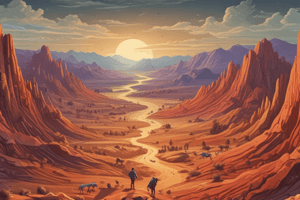Podcast
Questions and Answers
What was the challenge faced by Hutton, Lyell, Darwin, and others when developing their concepts of deep time?
What was the challenge faced by Hutton, Lyell, Darwin, and others when developing their concepts of deep time?
- Inability to interpret stratigraphic layers
- Difficulty in quantifying the age of ancient rocks and fossils (correct)
- Lack of understanding of fossil records
- Lack of access to ancient rock samples
Which concept is related to the idea of deep time in the text?
Which concept is related to the idea of deep time in the text?
- Faunal succession
- Correlation and index fossils
- Golden spikes
- Uniformitarianism and superposition (correct)
What is discussed in the section 'Time without numbers'?
What is discussed in the section 'Time without numbers'?
- The development of concepts of deep time without a way to quantify age (correct)
- The difficulty in interpreting stratigraphic layers
- The inability to quantify the age of ancient rocks and fossils
- The challenge of understanding fossil records
Which term refers to the identification of specific layers in different locations?
Which term refers to the identification of specific layers in different locations?
How did the lack of quantifying ancient rock and fossil ages impact the development of concepts of deep time?
How did the lack of quantifying ancient rock and fossil ages impact the development of concepts of deep time?
What is the scientific theory that suggests Earth's lithosphere comprises a number of large moving plates?
What is the scientific theory that suggests Earth's lithosphere comprises a number of large moving plates?
What determines the type of plate boundary where the plates meet?
What determines the type of plate boundary where the plates meet?
What process reduces the total surface area (crust) of the Earth at convergent plate boundaries?
What process reduces the total surface area (crust) of the Earth at convergent plate boundaries?
Which part of the Earth is composed of oceanic lithosphere and thicker continental lithosphere, each topped by its own kind of crust?
Which part of the Earth is composed of oceanic lithosphere and thicker continental lithosphere, each topped by its own kind of crust?
What experiences earthquakes, volcanic activity, mountain-building, and oceanic trench formation due to being geologically active?
What experiences earthquakes, volcanic activity, mountain-building, and oceanic trench formation due to being geologically active?
What is the process by which the edge of one tectonic plate is carried down under the other plate and into the mantle at convergent plate boundaries?
What is the process by which the edge of one tectonic plate is carried down under the other plate and into the mantle at convergent plate boundaries?
What determines the type of plate boundary where tectonic plates meet?
What determines the type of plate boundary where tectonic plates meet?
Which early concept developed during the first decades of the 20th century does the model of plate tectonics build on?
Which early concept developed during the first decades of the 20th century does the model of plate tectonics build on?
What is the process that reduces the total surface area (crust) of the Earth at convergent plate boundaries?
What is the process that reduces the total surface area (crust) of the Earth at convergent plate boundaries?
Which part of the Earth's lithosphere is made up of oceanic and thicker continental lithosphere, each topped by its own kind of crust?
Which part of the Earth's lithosphere is made up of oceanic and thicker continental lithosphere, each topped by its own kind of crust?
Flashcards are hidden until you start studying




